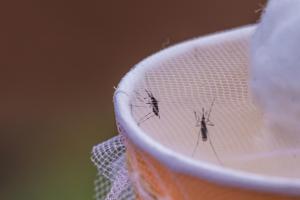Tackling malaria in Mali through stronger surveillance
Bamako – How can numbers save lives? In three malaria-prone districts in central Mali, regular recording of cases is helping local health officials keep track of infection trends, but more importantly, they can now trigger an emergency response when the infection threshold is crossed and helping to curb potential large outbreaks.
Through training in 2021, 62 health workers responsible for epidemiological surveillance in three pilot health districts (Diema, Koutiala, and Kenieba) prone to malaria outbreaks have honed their disease surveillance skills, primarily learning how to calculate the epidemic threshold from malaria infection data.
To enable early detection and response to malaria infection at the district level, the trained staff analyse routine epidemiological surveillance data generated at the health facility level.
“The health workers are not caught off guard by malaria outbreaks that can turn into a large-scale health emergency because they track the infection trend every month. This surveillance is beneficial to the population because by averting outbreaks we lower the health risks,” explains Dr Christian Itama Mayikuli, WHO representative in Mali.
A total of 27 districts in Mali have been identified as prone to malaria outbreaks. In these areas prevention activities were badly affected by the impact of the COVID-19 pandemic, especially at the onset of the crisis as people avoided health facilities for fear of infection. Additionally, insecurity and armed violence has also affected health services.
The malaria surveillance training organized piloted in Diema, Koutiala and Kenieba focused, among other things, on calculating the epidemic threshold, the importance of ensuring data quality, as well as developing disease investigation and outbreak response plans.
“During this training, I learned how to determine the epidemic threshold from the outpatient data register and the monthly activity reports to prevent malaria outbreaks and to ensure effective response,” says Dr Amadou Traore, technical director of the community health centre in Diema, a rural commune in the Kayes region in western Mali.
To monitor the malaria infection trends, regular meetings are organized to analyse the daily health information. An outbreak is defined as a sudden increase in the incidence of malaria in the health area where the disease is rare, based on the threshold previously obtained.
For example, in Diema District, in July 2022, Dr Traore projected 138 cases of malaria (mild and severe) in his health area. But only 66 cases were recorded. Also in October, 1,004 cases of malaria were projected, yet 965 cases were diagnosed and treated. By contrast, in August, 762 cases were expected, but 882 were treated.
When the outbreak threshold was reached in August 2022, public awareness raising focused on the correct use of mosquito nets and draining stagnant water around houses was conducted in the 20 villages of the health area involving community health workers and village chiefs as malaria cases were linked to the increased rainfall that year.
“When the threshold is reached the emergency response team is set up in coordination with the regional and national levels. Before the response, prevention allows us to identify the actors and the means necessary to respond to the epidemic,” says Dr Moussa Kone, Diema Chief District Medical Officer.
Thanks to the training organized by WHO with the support of the Government of Monaco through the Sahel Malaria Acceleration Project, health workers are now able to quickly detect an epidemic and intervene, which was not the case before.
"Before the training, there were difficulties in forecasting and alerts, and there was no system for detecting outbreak thresholds. Predicting malaria outbreaks in the community was complicated," said Dr Traore.
For districts with a high potential for malaria outbreaks, mastering the method of determining the outbreak threshold and building the capacity of health workers in prevention, diagnosis and clinical care are essential to improve the malaria prevention and control.
“Surveillance enables us to detect in time any unusual event related to malaria and to respond quickly to potential outbreaks and facilitate an evidence-based response, while also assessing the impact of disease control measures,” explains Dr Aïssata Kone, National Director of the National Malaria Control Programme.
According to Dr Mayikuli, the WHO representative in Mali, the expansion off the malaria surveillance training project up to 2024 will consolidate the gains made so far bolster progress towards the 2030 goal of eliminating malaria by 2030 in the Sahel.
Donor Visibility communication officer
WHO Regional Office for Africa
Email: bouboutoum [at] who.int (bouboutoum[at]who[dot]int)
Communications Officer
Regional Office for Africa
Email: lawsonagbluluf [at] who.int (lawsonagbluluf[at]who[dot]int)



